In golf, improving golf swing consistency is the cornerstone of mastering the game. Whether you’re a novice or a seasoned player, improving golf swing consistency can significantly elevate your performance on the course.
To achieve a consistent golf swing, focus on maintaining balance, proper alignment, and smooth tempo for the best golf ball control and best putters. If you Using the best golf grips for sweaty hands, you can achieve better swing consistency and control, even in tough conditions.
In this guide, I’ll explore techniques and tips that will help you improve golf swing consistency and enhance your overall game. Let’s delve into the strategies that can make a difference in every swing you take.
Understanding the Problem
The Frustration of Inconsistent Contact
Golfers often face frustration due to inconsistent contact with the ball, seeking ways to improve golf swing consistency effectively.
We’ve all been there. Standing over a promising shot, only to chunk the club behind the ball or catch it thin. This inconsistency in contact is one of the most common and frustrating issues golfers face. It stems from improper weight transfer and body mechanics during the swing.
The Key to Success: Divot in Front of the Ball
Key Focus Areas for Success
- Ensure your good grip is neither too tight nor too loose. A firm, comfortable grip allows for better control and fluid motion. Practice holding the club with a neutral grip to avoid hooking or slicing the ball.
Stance
- Your stance should be shoulder-width apart with knees slightly bent. This balanced position provides stability and allows for a full range of motion during the swing.
Alignment
- Proper alignment ensures your body is positioned correctly relative to the target. Align your feet, hips, and shoulders parallel to the target line. This promotes a straight and accurate shot.
Backswing
- A controlled backswing sets the foundation for a powerful strike. Focus on a smooth takeaway, keeping your arms straight and turning your shoulders fully. Avoid rushing this part of the swing.
Downswing
- Transition smoothly from the backswing to the downswing. Shift your weight from the back foot to the front foot while maintaining a steady head position. A consistent downswing ensures solid contact with the ball.
Follow-through
- A complete follow-through is essential for accuracy and distance. Allow your body to rotate naturally, and finish with your chest facing the target. This indicates a well-executed swing.
Summary Table
| Key Focus Area | Description |
| Grip | Firm but comfortable grip for control |
| Stance | Balanced position with knees slightly bent |
| Alignment | Body aligned parallel to target line |
| Backswing | Smooth, controlled takeaway |
| Downswing | Smooth transition, weight shift |
| Follow-through | Complete rotation, chest facing target |
Focusing on these areas will lead to a more consistent and effective golf swing. Practice regularly and pay attention to each component to improve your overall performance on the course.
Understanding Inconsistent Contact
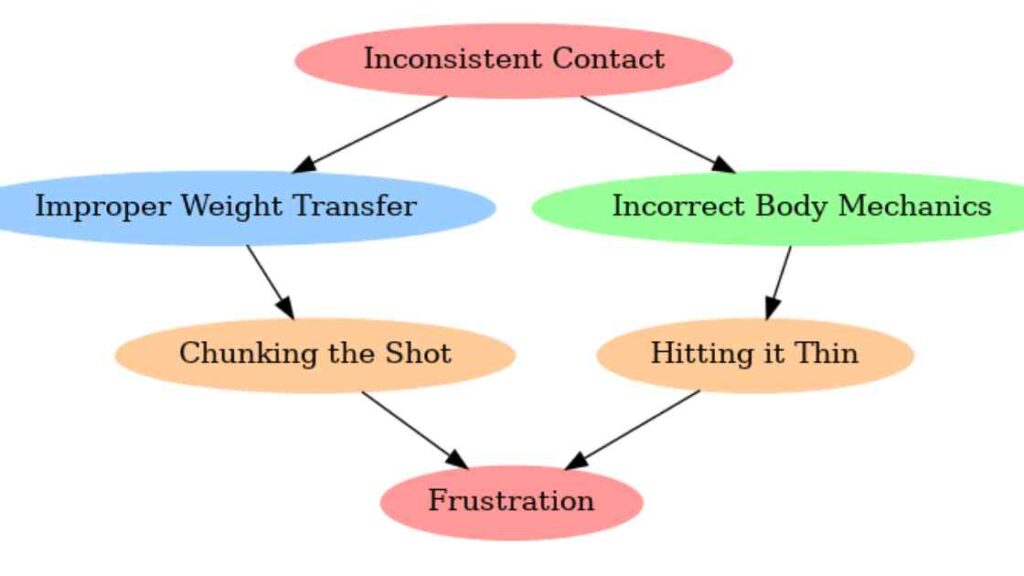
The Ultimate Drill for Clean Contact
Tools You’ll Need
Before we get into the drill, let’s talk about a simple but effective tool: Dr. Scholl’s Odor-X Foot Powder Spray. This spray shows up very white on the ground, making it perfect for drawing lines on the turf. It’s also useful for marking your clubface to see where you’re making contact.
Setting Up the Drill
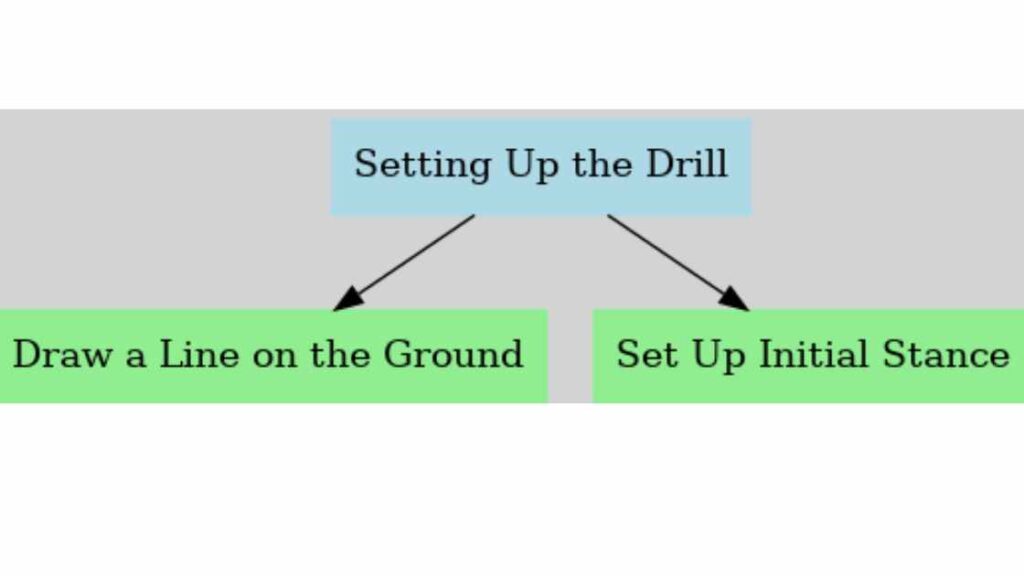
- Draw a Line on the Ground: Spray a straight line on the turf. This line will serve as your reference point.
- Initial Stance: Set up as though the line is your golf ball. Take your normal stance to start.
The Step-Forward Drill
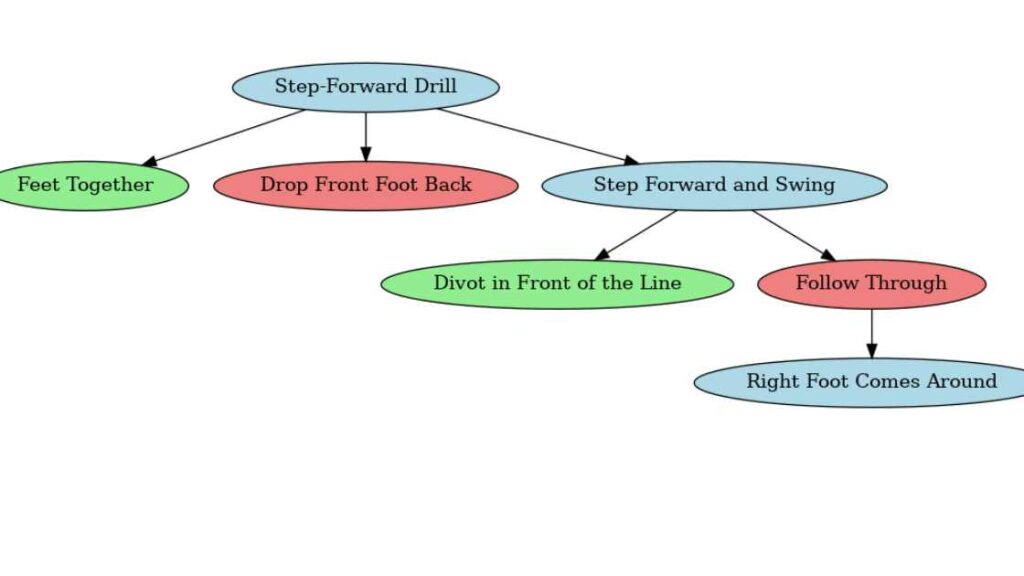
- Start with Feet Together: Begin with your feet together.
- Drop the Front Foot Back: Move your front foot back until it’s almost touching your back foot.
- Step Forward and Swing: Take a step forward with your front foot, swing, and aim to make a divot in front of the line. As you follow through, let your right foot come all the way around, just like you’re walking down the fairway.
Practice Without the Ball
Initially, practice this drill without a ball. Focus on making a divot in front of the line. This helps you get a feel for the proper weight transfer and body movement.
Adding the Golf Ball
Once you’re comfortable, place a good golf ball on the line. Aim to make contact on the line or slightly in front of it. Don’t worry if you don’t hit it perfectly at first. The goal is to get used to the forward weight shift.
Refining the Drill
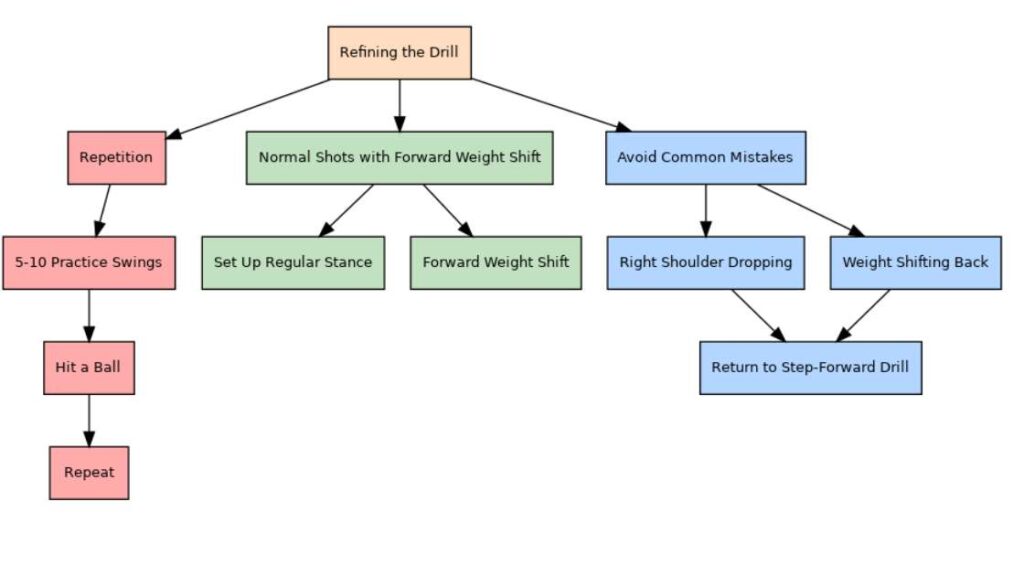
Repetition is Crucial
Do five to ten practice swings without a ball, then hit a ball, and repeat. This builds muscle memory and helps you get comfortable with the movement.
Normal Shots with Forward Weight Shift
Once you’ve mastered the drill, transition to normal shots. Set up with your regular stance but maintain the same forward weight shift. Your right toe should be the only part of your back foot touching the ground in the follow-through.
Avoiding Common Mistakes
Watch for common errors like the right shoulder dropping or the weight shifting back. If these happen, return to the step-forward drill to reinforce the correct movement.
Poor Grip
- Ensure your grip is neither too tight nor too loose.
- Position your hands correctly; the V’s formed by your thumbs and forefingers should point towards your right shoulder (for right-handed players).
Incorrect Stance
- Maintain a balanced stance with your feet shoulder-width apart.
- Distribute your weight evenly between both feet.
- Slightly bend your knees and keep your back straight.
Misalignment
- Align your body parallel to the target line.
- Use alignment aids or practice with a club laid on the ground to check your alignment.
Swing Path Issues
- Avoid an outside-in swing path which can cause slices.
- Focus on bringing the club back along the correct plane and following through towards the target.
Over-swinging
- Swinging too hard can lead to loss of control and consistency.
- Aim for a smooth, controlled swing with a focus on rhythm and timing.
Lack of Follow-Through
- Ensure you complete your swing with a full follow-through.
- A proper follow-through indicates good swing mechanics and balance.
Neglecting the Short Game
- Spend time practicing your putting, chipping, and pitching.
- Consistency in the short game is crucial for lowering your score.
Skipping Warm-Ups
- Always warm up before playing to prepare your muscles and avoid injury.
- Incorporate stretching and a few practice swings to get into the rhythm.
Additional Tips for Better Contact
The Straight-Line Release
One common misconception is that you need to hold your lag through contact. Instead, focus on releasing the club. As you come through contact, your hands should be moving a short distance while the club moves a long distance, creating a whip-like effect.
This technique, known as the straight-line release, generates speed and power with minimal effort.
Learning from the Pros
Observing professional golfers like Dustin Johnson and Sergio Garcia can provide valuable insights. Despite their different swings, they achieve similar positions at impact due to their understanding of swing mechanics and physics.
Divot Position and Swing Quality
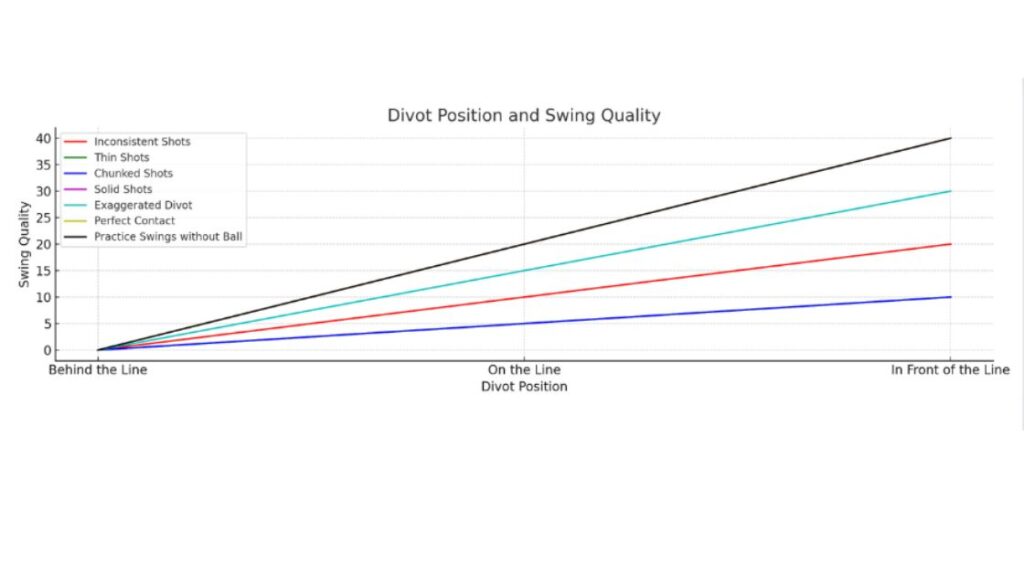
Weight Transfer and Contact Consistency
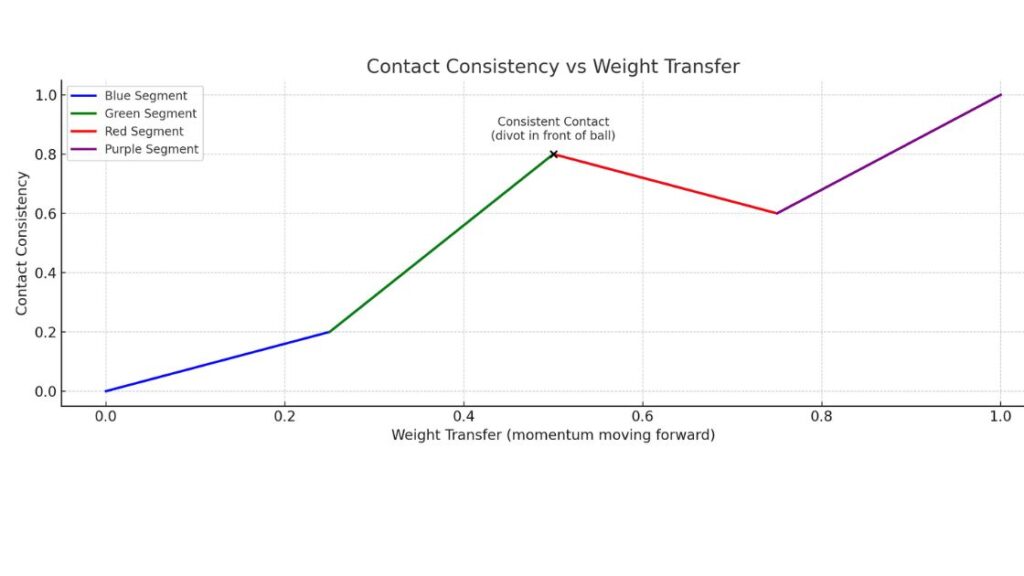
Technical Breakdown of Improving Golf Swing Consistency
Achieving a consistent golf swing requires a detailed understanding of its mechanics. The golf swing involves a complex interplay of movements, and mastering these can significantly enhance your performance.
Body Mechanics
Weight Transfer
One of the fundamental aspects of a good golf swing is effective weight transfer. As you begin your backswing, your weight should shift to your back foot. This transfer builds potential energy, akin to winding up a spring.
During the downswing, smoothly transferring your weight to your front foot releases this energy, powering the club through the ball. Poor weight transfer can result in weak or inaccurate shots, as it disrupts the balance and rhythm essential for a consistent swing.
Shoulder Position
Shoulder positioning is another critical element. At the top of your backswing, your shoulders should turn fully, creating a 90-degree angle with your spine. This position ensures maximum torque, which is crucial for generating power.
Additionally, maintaining a stable shoulder tilt helps in keeping the swing plane consistent. On the downswing, your shoulders must rotate back towards the ball in a synchronized manner, ensuring that the clubface strikes the ball squarely.
Misalignment in shoulder rotation can lead to slices or hooks, severely affecting shot accuracy.
Shoulder Position and Shot Outcome
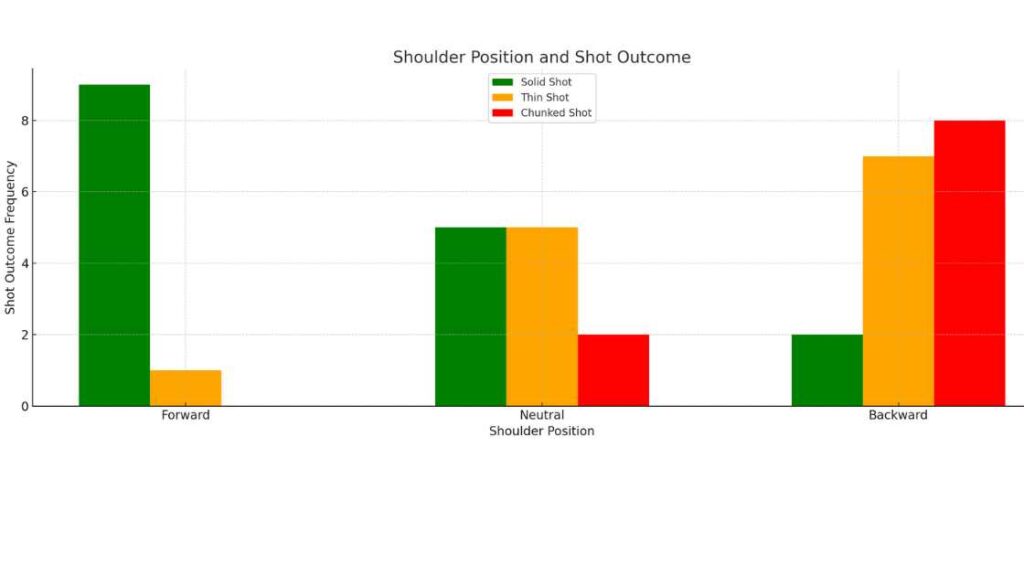
Comparison of Golf Swings
Proper Stance and Grip
Start with your feet shoulder-width apart and knees slightly bent. Your grip should be firm but relaxed, ensuring the club feels like an extension of your arms. Align your shoulders, hips, and feet parallel to the target line.
Backswing Fundamentals
During the backswing, focus on rotating your shoulders while keeping your lower body stable. Your arms should stay straight, and the club should reach a 90° angle at the top of the swing. This sets up a powerful and controlled downswing.
Downswing and Follow-Through
Initiate the downswing by shifting your weight to your front foot. Keep your head steady and eyes on the ball. As you make contact, aim to strike the ball first, then the ground, ensuring a clean hit. Follow through fully to maintain balance and control.
Practice Drills
Incorporate drills like the “pause at the top” and “impact bag” to improve timing and impact position. These drills help you understand the mechanics of a consistent swing and build muscle memory.
Comparison of Golf Swings
| Golfer | Key Characteristics | Impact Position |
| Johnson | Powerful, high swing speed | Club releases 45° past contact, creating speed |
| Garcia | Smooth, consistent ball striking | Similar impact position despite different swing style |
| Amateurs | Inconsistent contact | Often chunk or thin shots due to poor mechanics |
Benefits of the Step-Forward Drill
The Step-Forward Drill is an effective exercise for golfers aiming to improve their swing consistency. By incorporating this drill into your practice routine, you can reap several benefits that enhance your overall performance on the course. Below is a table summarizing the key benefits:
| Benefit | Description |
| Improved Balance | Enhances your balance during the swing, leading to more controlled and accurate shots. |
| Better Weight Transfer | Helps in mastering the proper weight shift from the back foot to the front foot, crucial for a powerful swing. |
| Enhanced Timing | Assists in developing better timing and rhythm, ensuring a smoother and more fluid swing. |
| Increased Power | Promotes a stronger and more powerful swing by teaching the correct use of body mechanics. |
| Consistency | Fosters a repeatable swing motion, leading to greater shot consistency. |
Improved Balance: The Step-Forward Drill requires you to step forward during your swing, which inherently improves your balance. A well-balanced swing is critical for maintaining control and ensuring the accuracy of your shots.
Better Weight Transfer: This drill emphasizes the correct weight shift from the back foot to the front foot. Proper weight transfer is essential for generating power and maintaining swing consistency.
Enhanced Timing: By practicing the Step-Forward Drill, you can develop a better sense of timing and rhythm. This ensures your swing is smooth and fluid, reducing the likelihood of mishits.
Increased Power: This drill encourages the use of proper body mechanics, which can significantly increase the power of your swing. A powerful swing translates to longer shots and better performance.
Consistency: Perhaps the most crucial benefit is the development of a repeatable swing motion. Consistency is key in golf, and this drill helps engrain a reliable swing pattern.
Incorporating the Step-Forward Drill into your practice routine can significantly improve your golf swing, leading to better performance and more enjoyable rounds.
FAQ
What are the basics I need to know to improve my golf swing consistency?
The basics of improving your golf swing consistency involve three key elements: grip, stance, and posture.
- Grip: Make sure you hold the club correctly. Your hands should work together as a single unit.
- Stance: Your feet should be shoulder-width apart, with your weight evenly distributed.
- Posture: Keep your back straight and bend slightly at the hips. Your knees should be slightly flexed.
How can I improve my swing tempo?
Improving your swing tempo is all about finding a rhythm that works for you and sticking to it. Here are a few tips:
- Count to three: Count “one” on the backswing, “two” at the top, and “three” on the downswing.
- Use a metronome: Practice with a metronome to maintain a steady tempo.
- Practice slow swings: Practice swinging in slow motion to feel the proper tempo and rhythm.
Why is my golf swing inconsistent?
Inconsistencies in your golf swing can be due to several factors:
- Lack of practice: Consistency comes with regular practice.
- Poor fundamentals: Incorrect grip, stance, or posture can lead to an inconsistent swing.
- Mental game: Nerves and lack of focus can also affect your swing.
How can I practice to improve my swing consistency at home?
You can improve your swing consistency at home with these exercises:
- Mirror drills: Practice your swing in front of a mirror to check your form.
- Swing with a weighted club: This helps build strength and improve your tempo.
- Golf net: If space allows, set up a golf net to practice full swings.
Regular, focused practice at home can make a big difference.
What role does physical fitness play in a consistent golf swing?
Physical fitness is crucial for a consistent golf swing. Flexibility, strength, and endurance all play roles.
- Flexibility: Helps you achieve a full range of motion in your swing.
- Strength: Core and leg strength are particularly important for power and stability.
- Endurance: Helps maintain your form throughout the entire round.
Regular exercise focusing on these areas can greatly improve your swing consistency.
How important is it to get professional golf lessons?
Professional golf lessons can be very beneficial for improving swing consistency.
- Expert guidance: A professional can identify and correct flaws in your swing.
- Personalized feedback: Lessons are tailored to your specific needs and goals.
- Accelerated improvement: Professional advice can help you improve faster than practicing on your own.
Conclusion
Improving your golf game takes time and practice, but with the right drills and focus, you can achieve clean, consistent contact. Start with the step-forward drill, focus on your weight shift, and refine your technique with regular practice.
Improving your golf swing consistency is crucial, and investing in the best golf shoes can provide the stability and support you need.
Remember, the key lies in maintaining a balanced stance, leveraging proper body mechanics, and staying patient with your progress. Consistency in improve golf swing consistency is not an overnight feat, it’s a journey that demands persistence and resilience.
As you apply these principles, track your development and celebrate each milestone, no matter how small. Ultimately, improving golf swing consistency is about mastering the fundamentals and integrating them into your unique style. With perseverance and a structured approach, you can steadily improve golf swing consistency and enjoy more rewarding rounds on the course.













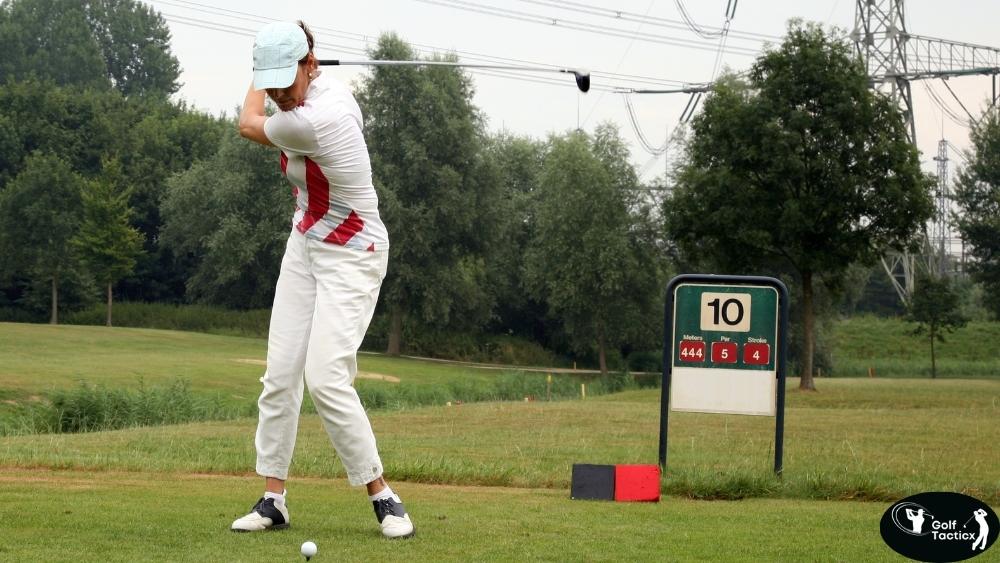


Leave a Reply